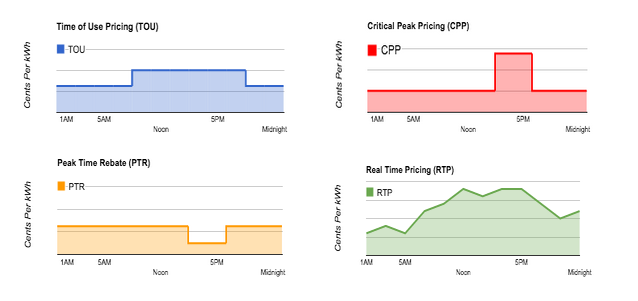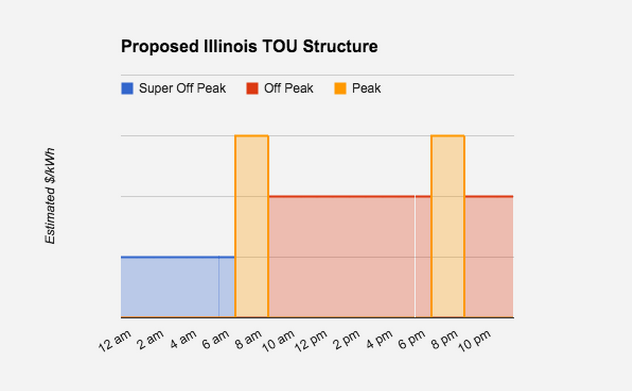
At most times of the year, much of the electricity generating capacity in the United States stands idle. In fact, on average we use less than half of the available capacity.That’s because the electric power system is built to handle demand at its peak - those few sweltering summer days when everyone’s AC is running full blast. What utilities pay for power at those times of peak demand drives up the price we pay for electricity around the clock and all year long. One way to reduce spikes in demand is with rates that vary by time of use. By pricing electricity higher at times when demand typically peaks, consumers large and small have an incentive to reduce their electricity use when it matters most to the power grid - reducing the costs of the system overall.
Time varying rates (TVR) come in four general categories: Time-of-Use (TOU), Critical Peak Pricing (CPP), Peak Time Rebate (PTR) and Real Time Pricing (RTP). TOU is the most basic pricing scheme which consists of pre-defined peak and off-peak time periods with a tiered pricing structure for each. RTP is the most sophisticated and most variable, with hourly prices determined by day-ahead market prices or real-time spot market prices for electricity. In between are CPP, in which fixed rates are punctuated by higher rates charged during peak demand events (announced in advance), and PTR, which is essentially the reverse - customers receive a rebate when they reduce their usage during a peak demand event.

TVR is not a new concept. Many large commercial and industrial customers are already on TVR. But it is less common for residential customers. According to the EIA, less than 3% of residential customers participate in TVR programs.
In the late 1980s and 1990s, there was a wave of TVR experiments run across the country with promising results, but they never caught on. There was some customer backlash, and furthermore, utilities had little incentive to offer TVR: they feared losing revenue. Also, at the time TOU metering was relatively expensive and the difference in cost between baseload and peaking plants was not as significant.
Since then, peak demand has grown much faster than overall demand, and the cost of meeting demand peaks has driven up costs overall. Now, with enabling technologies like advanced metering, and advanced energy companies developing energy management products and services that give customer the information and tools to respond to price signals, more states are beginning to implement TVR.
In AEE’s PowerPortal database we have almost 500 TVR rates, for residential and small and medium commercial customers, of which almost 85% are TOU, under 10% are CPP, under 5% are PTR and around 3% are RTP. Arizona leads the nation in TVR participation, accounting for 30% of overall TVR participation. Here are some examples of recent actions, as TVR seems poised for takeoff:
As part of a broader grid modernization effort, the Massachusetts Department of Public Utilities adopted a new default time varying rate structure, with utilities required to file new rate plans by August 5, 2015. All residential customers on basic service would be placed on Time-of-Use (TOU) pricing as the default: a tiered rate with special higher pricing during specified peak demand times, and lower pricing during the rest of the day. Customers will have the ability to opt-out and choose a flat rate instead, though with a Peak Time Rebate (PTR), so even flat-rate customers have an incentive to curb peak time use.
The Tennessee Valley Authority, the nation’s largest federally owned electric utility, is also considering adding TVR options for their nine million customers in Tennessee and portions of Alabama, Mississippi, Kentucky, Georgia, North Carolina and Virginia. The TVA board will vote in August on the new rates and, if approved, they could go into effect as soon as this October. TVA President and CEO Bill Johnson said, “Overall, we must be able to efficiently match power supply to changing demands over the long term and from day to day.”
The California Public Utilities Commission (CPUC) also has an open proceeding to examine the state of TVR and to establish potential pathways from the existing fixed tiered residential rate structure towards one that utilizes TVR. CPUC Staff have proposed a transition to default TOU rates starting in 2018, once statutory restrictions are lifted. The CPUC is expected to issue a proposed decision on the rate design portion of the proceeding sometime this month.
In Illinois, the Citizens Utility Board (CUB) and the Environmental Defense Fund (EDF) are asking the Illinois Commerce Commission to require the state’s two largest investor-owned utilities to offer TOU rates. In the filing, they propose a three block structure that would look like the chart below.

A handful of states already offer real-time-pricing (RTP) rates for residential customers, including Oklahoma, Illinois, and Ohio. According to CUB Executive Director David Kolata, Illinois has already seen cost savings of 10% to 15% on real-time pricing programs for participating customers from Ameren Illinois and Commonwealth Edison.
TVR is an important part of moving toward a 21st century electricity system. It reduces stress on the power grid and lowers wholesale energy and capacity costs by alleviating the need for inefficient and costly peaking plants. TVR also allows savvy consumers to capture the benefits of managing their electricity usage. In the past, TVR seemed like a dramatic shift from conventional rate design, but today’s technology has significantly lowered the barriers to customer adoption by increasing customer awareness and providing tools to react to market signals. Early adopters have proven that the market is willing to accept the change. Now, with grid modernization proceedings popping up from California to Minnesota to Massachusetts and New York, TVR is a key part of the discussion.
For more information on electric utility time varying rates go to AEE’s PowerPortal (sign up for a free trial here) - your one-stop shop for high-value information about each state’s energy policies and key players.
See time varying rates broken down by utility, how many customers use TVRs and what rates do they offer and to whom. That and much more!
